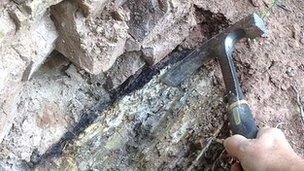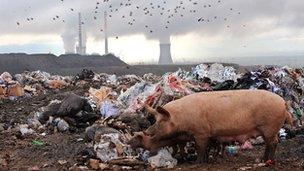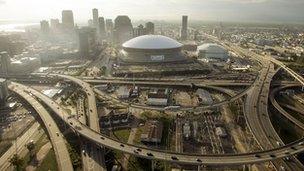Leaving our mark: What will be left of our cities?
- Published

Some cities are likely to leave traces in Earth's geology, while others will vanish
From our cities, to our farms, to our rubbish, humans have firmly stamped their mark across the planet. In part one of a two-part feature, Andrew Luck-Baker, from the BBC's Radio Science Unit, explores the legacy our civilisation will leave in the rocks of the future. You can read part two here.
"We have pushed the Earth down a different trouser leg of history and it will evolve differently than if we had not appeared."
Geologist Jan Zalasiewicz mines a metaphor from Terry Pratchett's Discworld to sum up a view shared by many Earth scientists: humanity's impact on the globe is so great and varied that we have launched a new geological time period in the Earth's history. Its name is the Anthropocene - the human epoch.
The University of Leicester researcher is one of the experts interviewed in the current BBC World Service radio series Discovery: The Age We Made.
Dr Zalasiewicz also chairs an international task force of geologists which is assessing whether it is appropriate to formalise the Anthropocene's status in Earth Science.
In order for it to take an official place alongside the Mesozoic Era, the Jurassic Period and the Pleistocene epoch, geologists need to be convinced that we are leaving behind a sufficiently distinctive sequence of rocks and stand-out fossil record in the sediments being laid down in today's seas, lakes and flood plains.
Fossil fuel emissions, climate change, agriculture, accelerated species extinction, chemical pollution and megacities will all express themselves in various ways in sediments in the seas, lakes and rivers in our times, say many Earth scientists.
Millions of years from now, those layers of sediment will have been compacted into rock such as sandstones, mudstones and limestones.
But imagine Earth scientists in the far future. What would they find in the strata of the Anthropocene epoch? What evidence might lead them to conclude the Anthropocene Earth was markedly different from the planet in the preceding epoch known as the Holocene (the last 12,000 years of relative climate stability).
Wrong trouser?
There are two aspects of our geological legacy to think about. There are the rocks (and the fossils they contain) which will form as the Anthropocene unfolds fully over the coming thousands or millions of years. There is also what Earth scientists call the boundary layer of the Anthropocene.

A thin layer of coal marks the boundary between the Triassic-Jurassic periods
This will be a relatively thin sequence of rock which represents the last century or two, and at least the next one hundred years to come. It will contain evidence of contemporary global environmental change: the transitionary events which launched the planet into Dr Zalasiewicz's alternative trouser leg of geological time.
Prof Paul Olsen of the Lamont-Doherty Earth Observatory in New York travels the world studying the boundary layer between the Triassic and Jurassic periods, which formed 200 million years ago. Dinosaurs first evolved in the Triassic and became the dominant land creatures soon after the dawn of the Jurassic.
In an outcrop of rocks in a suburban development in Pennsylvannia, Paul Olsen showed The Age We Made team, the boundary layers between the Triassic and Jurassic. There are a few centimetres thickness of white clay, above which there is an even thinner band of coal.
Immediately below the white layer, the older rock contains abundant and diverse plant fossils, representative of a rich forest ecosystem. The white boundary clay contains nothing but the fossil spores of a couple of fern species.
Ferns are sometimes called "disaster taxa" because they are the first plants to re-colonise a devastated landscape. Across the line between the yellow sandstone and white clays, we see the evidence of an ecological collapse and a mass extinction which took between 10 and 100 years, estimates Olsen.
Elsewhere in the world, at this 200 million year old time horizon, there are great thicknesses of lavas. These basalt flows are part of a gargantuan volcanic eruption which ultimately covered an area equal to one third of the Moon's surface.
The favoured hypothesis is that this volcanic episode added so much carbon dioxide and sulphur dioxide into the atmosphere that climate change devastated both terrestrial and marine ecosystems. At least 75% of species became extinct.
When asked about the Anthropocene, Paul Olsen says: "Based on the kinds of changes humans have already produced… it is clear we will be a geological marker, that humans are a geological force and that we are in a new geological time period the likes of which the Earth has never seen."

Humankind's impact on the environment has been unprecedented
One kind of stratigraphic marker our species will leave behind in a few areas on the planet will be the "fossilised" remains of our cities, assuming they are ultimately abandoned. They will be the Anthropocene equivalents of the lava flows which launched the Jurassic: physical remnants of the planetary transition's root cause.
According to Jan Zalasiewicz, only certain cities will leave distinctive remains in the rocks, over the timescale of millions of years. Inland megacities such as Dehli and Moscow will slowly erode into anonymous sands and gravels, spread far and wide.
The structure of coastal cities such as Amsterdam, New Orleans, Dhaka and maybe New York are more likely to be preserved in a partially recognisable state: particularly those on subsiding land. With global sea level rise also on their side, discrete chunks of buildings and city substructures have a reasonable chance of burial and entrapment in the sedimentary record before the waves wear them away.
"The underground sewerage and electricity systems, and any subways, will be nicely preserved. Above, the buildings will collapse into a mass of rubble and those will be preserved rather more chaotically. Nonetheless they will form a kind of strata very clearly different to anything that's gone before," says Jan Zalasiewicz.

New Orleans may be one of those cities that is preserved in a recognisable state
This is because the shapes and assemblages of materials in these "urban strata" will be unlike anything Nature would throw together. Yet the stuff of cities will be durable because most of it is made from substances which quarried or mined from the crust.
"Concrete is like a sandy limestone so that probably has very good preservation potential," adds Zalasiewicz. "Brick will soften and turn grey from red. It will stay brick-shaped but probably flatten a little bit.
Glass will probably go milky and turn into a finely crystalline solid. Steel will probably rust and dissolve away but leave holes where it's been. So we can apply the principles of geology to the new geological strata that we're making, to predict what they'll look like in tens to hundreds of million year's time. "
Mass extinction
The fossil record of animals and plants at the start of the Anthropocene is also worth considering, says palaeontologist Anthony Barnosky of the University of California, Berkeley. "Would it really look different from what we now know as the Holocene?"
Geological periods and epochs are usually defined by the particular groups of animals and plants that typified the time. The boundaries between periods are also marked by multiple species extinctions and, in five cases in the Earth's history, mass extinctions.

Extinctions could be hundreds of times faster than the background rate
Mass extinctions, says Anthony Barnosky, are geological events in which at least 75% of animal species were wiped out. The last one happened 65 million years ago when a large asteroid crashed into the Earth. It took out the dinosaurs and a great many more species on the land and in the sea.
"We are causing lots and lots of other species either to have already gone extinct or to be heading down an extinction trajectory. So I like to compare what's going on today to the asteroid that wiped out the dinosaurs - except that now we are the asteroid," says Barnosky.
His recent calculations, published last year in a landmark paper in the journal Nature, were good news for proponents of an official Anthropocene. They were bad news for the rest of us.
Prof Barnosky and colleagues compared the rates of known species extinctions in mammals, birds and amphibians during the last five centuries with those estimated from the fossil record during the previous Big Five die-outs of the geological past.
Their analysis of extinction speeds over the last 500 years is 12 times greater than during times of relative evolutionary stability. Tony Barnosky himself says this number emerges from an extremely conservative analysis and suspects the true rate is higher. Other researchers contend that the rate is hundreds of times faster than the background rate.
Barnosky concludes: "If we continue business as usual and we see the same rates of biodiversity loss we've seen over the past one hundred to five hundred years, we will see the magnitude of loss that was characteristic of the dinosaurs dying out - in a couple of centuries, maybe sooner."
Discovery: The Age We Made is a four part series on the BBC World Service. It is broadcast on Mondays at 1932 and 0432 GMT, Tuesdays at 1132 GMT and Sundays at 0132 GMT. Each episode is available as a download after airing at http://www.bbc.co.uk/programmes/p002w557
The series is presented by Gaia Vince and produced by Andrew Luck-Baker.
- Published3 November 2012
- Published26 March 2012
- Published11 May 2011